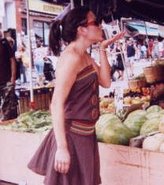 When Gustave Eiffel made his mark on paris it was innovation and engineering he had in mind moreso than aesthetics.
When Gustave Eiffel made his mark on paris it was innovation and engineering he had in mind moreso than aesthetics.Despite controversial receipt by the general public, it was accepted as a remarkable structure in design and complexity, yet it was (and still is)undeniably an eyesore.
Two years later, in 1891, the Czechosolvakian Republic constructed a miniature replica of the Parisian peak. It towers the city in plain view from any angle, marring the landscape of one of Europe's most beautiful cities.
The Petrin Tower is due some recognition, however, for its historical role in Czech(-osolvakian)telecommunications. (A journalism student myself, I have come to appreciate these sorts of feats although I cease to understand communications technology beyond the age of the printing press...). The steel structure was originally used as an observations and transmissions tower. I'm not sure what they were observing then, but it now offers a 360 view of the city scape. Lovely.
In the 1950s it was used for regular television broadcasting through a system of antennas mounted on the tower top. For 40 years it distributed all sorts of Czech programming including who-knows-what sort of Stalinist propaganda and neo-Stalinist numbo-jumbo in its earlier years. That tidbit wasn't included in the brief 'Tower History' flyer I was handed before my ascent.
That brings me to the climb.
In 1998 the Spojprojekt Praha Company embarked on a renovation and restoration of the Petrin Tower making it accessible to the public and most notably an unmistakable tourist trap - er, attraction.
I'm not a sucker for these sorts of things, but once you've strapped your quads and strained your calves scaling the Petrin Hill to find yourself at the tower's base, you may as well gird your loins and go for it.
Besides, It's only 60kc which is peanuts of the quality you might feed to a Bohemian circus elephant.
I embarked on the first of 299 steps, not without first asking the lady at the ticketbooth why they didn't just engineer one last step into the design. She replied with a confused and still contemplative shrug of the shoulders.
I tried counting just to make sure it wasn't actually 300 but lost it at around 42 steps, the increasing rhythm of each breath confusing the count of my steps, not to mention I was chewing a piece of gum. Far too much going on at once.
I was indeed distracted by my breathlessness, a consequence of my lack of general fitness coupled with the breath-taking views at each plateau. I paused at one of these for a rest and to have my photo taken by a good-looking Spaniard before continuing to the top of the tower.
The view wasn't spectacular as such, but aided my orientation of the city and the winding path of the Vltava River which cuts through its centre. I noticed small structures amidst remarkable monuments and a river of people - tourists - running through them.
My attention was struck and stuck, however, on a single clothesline spanning the sunlit breadth of a tall residential building. Panties and pairs of socks were neatly pegged between a few t-shirts along its length. I recalled the upheaval in Aurora last summer where it was made illegal to hang clothes to dry - a breach of property regulations. Residents faced prosecution and were left to resort to the unenvironmental and uneconomical method of their Maytag. As recently as November municipalities the Ontario town was calling on provincial government to initiate legislation overriding subdivision property agreements and making the 'humble' clothesline a regular siting once again.
It is a passionate cause. There is even a "Right to Dry" movement.
The argument, at its core, is one of aesthetics. The property owners believe a string-line of socks and underwear is an eyesore. Residents argue there is some intrinsic beauty here, nostalgic in a sense, not to mention hanging clothes to dry is less costly and more environmentally sound.
I stood atop the Petrin Tower - this eyesore that offers such eye-pleasing views.
I thought about the Eiffel Tower, equally reviled for its cold appearance.
Yet both are beautiful in their symbolism and remarkable in their historical relevance.
Both are necessary as the clothesline.
Behold. Breathe. Breath deeply.
And descend.
